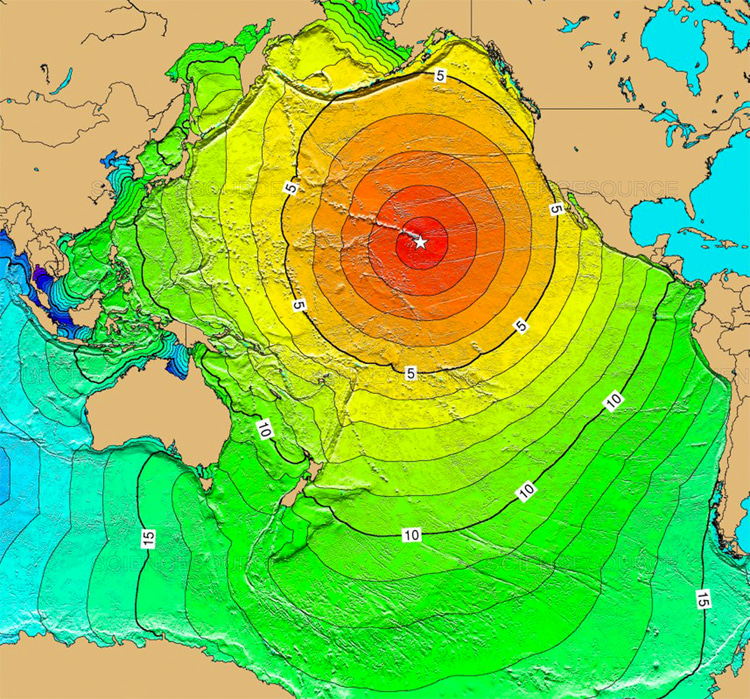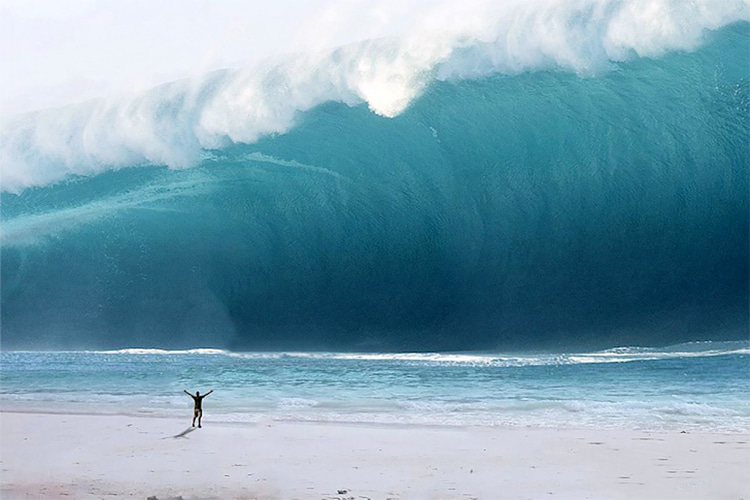Tsunamis are huge waves generated by disturbances on the ocean floor caused that are often caused by large earthquakes, underwater volcanic eruptions, and even meteor impacts.
A tsunami travels at high speeds of up to 590 miles per hour (950 kilometers per hour) in the open ocean.
This means that a tsunami wave might travel as fast as a jet airplane, although wave heights in the epicenter only rise 3.2 feet (one meter).
The time period between tsunami waves is extremely long and ranges between several minutes and a few hours.
The energy and power of a tsunami are, therefore, not comparable with a regular groundswell.
A tsunami wave is a force of Nature.
As soon as it reaches shallow waters near coastal regions, the wave's traveling speed decreases, builds in height (easily up to 100 feet/30 meters), and causes flooding and devastation.
When the wave retreats, everything can be swept out to sea.
The 2004 tsunami resulted in an undersea earthquake in the Indian Ocean and killed around 238,000 people in 11 nearby countries.
Most of these people died from the initial landfall of the waves and resulting floods.
Tsunami waves are wrongly named tidal waves because tides don't play any role whatsoever.

A Sneaky Giant
Tsunami Travel Times (TTT) software can calculate the arrival times of tsunamis, but it is not infallible due to bathymetry or/and epicenter estimation inaccuracy.
The picture above illustrates the magnitude 7.4 Ms earthquake and consequent tsunami event that hit the Hawaiian archipelago on November 29, 1975.
The colors tell us the arrival times of the infamous wave: red (1-4 hours), yellow (5-6 hours), green (7-14), and blue (15-21).
Normal swells have wave periods ranging from five to 20 seconds.
A tsunami has a wave period (time between two waves) that could go from ten minutes to two hours.
Around 80 percent of all "killer waves" are generated in the Pacific Ocean's "Ring of Fire."
The National Oceanic and Atmospheric Administration's National Data Buoy Center issues warnings about swells that may indicate tsunamis caused by underwater earthquakes.
A tsunami comes as a series of waves. The population must find protection in higher regions or nearby mountains.
The word tsunami is Japanese for "harbor wave." Tsunami waves can't be surfed.
Rules Rewritten
The idea that tsunamis usually decrease in height continuously and that the maximum tsunami height onshore could not exceed the depth of the seafloor has been updated.
The earthquake zones off of certain coasts - like those of Japan and Java - make them especially vulnerable to tsunamis.
A study authored by Utku Kanoglu and Costas Synolakis changed the way scientists explain the rules of tsunamis.
Until now, it has largely been believed that the maximum tsunami height onshore could not exceed the depth of the seafloor.
Recent research shows that when focusing occurs, the scaling relationship breaks down, and flooding can be up to 50 percent deeper with waves that do not lose height as they get closer to shore.
Also, it was thought that tsunamis usually decrease in height continuously as they move away from where they are created and grow close to shore, just as wind waves do.
The study's authors instead suggest that the crest of the tsunami remains fairly intact close to the source.
"Our results show that some shorelines with huge earthquake zones just offshore face a double whammy: not only they are exposed to the tsunamis, but under certain conditions, focusing amplifies these tsunamis far more than shoaling and produces devastating effects," explained Utku Kanoglu, professor at the Middle East Technical University.
